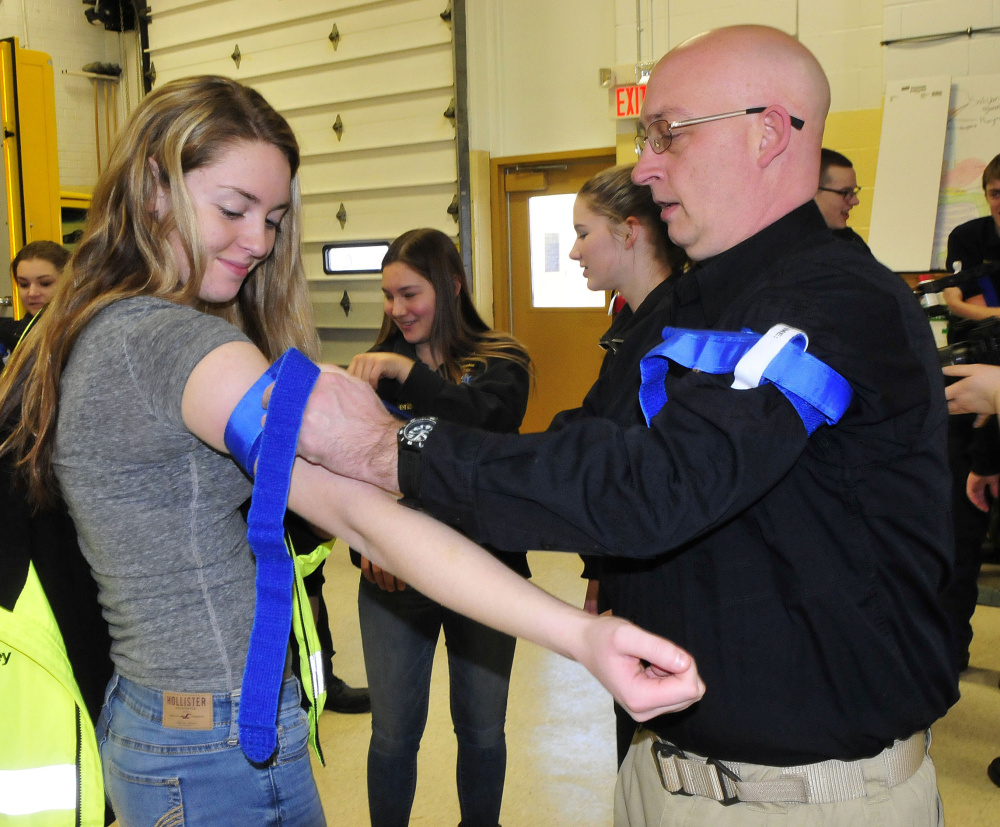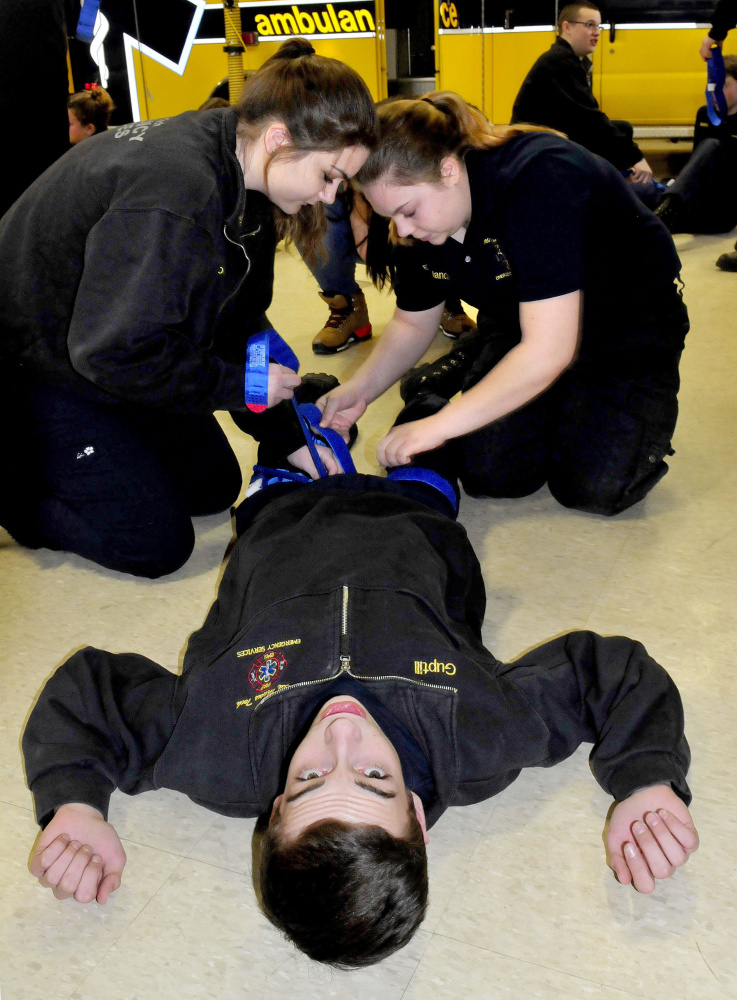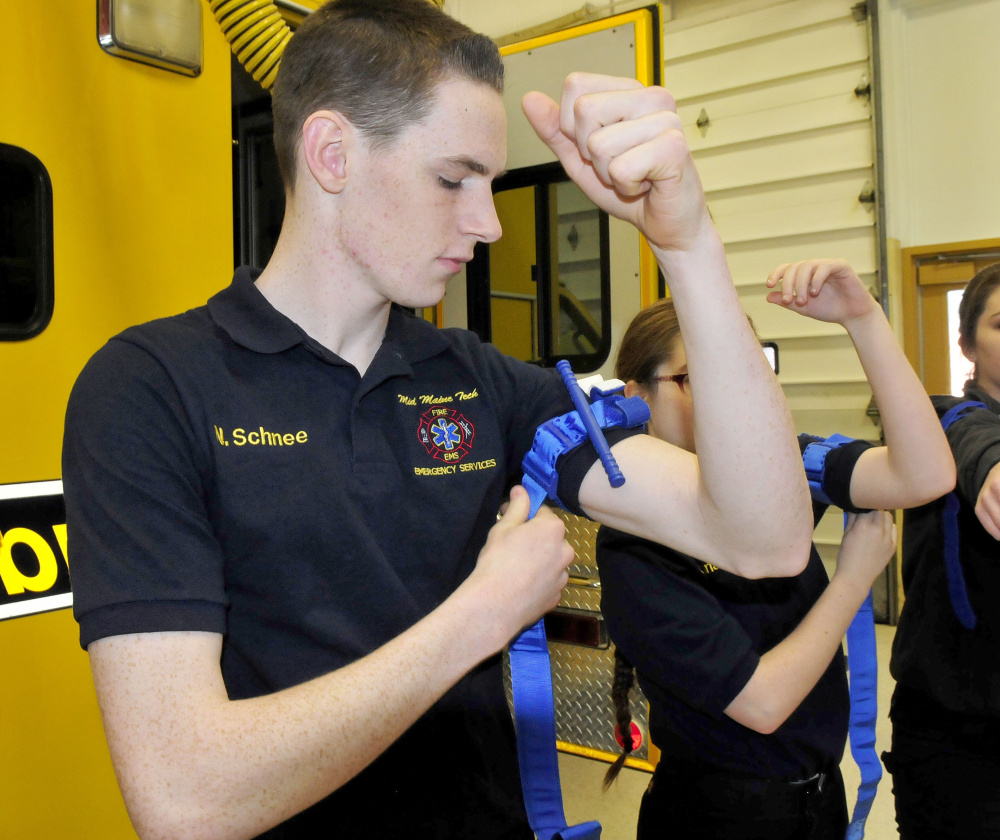WATERVILLE — If a mass shooting or other large casualty situation happened in the community, students and faculty from the Mid-Maine Technical Center would be ready to respond and aid victims.
Fifteen teenagers in an emergency medical technician-firefighter class at the school Thursday learned from a federal expert how to stop victims from bleeding to death before medical personnel arrive.
Paul Brooks, EMS program manager for the Office of Health Affairs in the U.S. Department of Homeland Security, taught the juniors and seniors how to distinguish wounds that are life-threatening from those that are not. He showed them how to apply tourniquets to wounds that can cause a victim to bleed to death, and how to pack and apply pressure to wounds.
Brooks reminded students of the shooting casualties in Newtown, Connecticut; at Columbine High School in Colorado; in Orlando, Florida; at Fort Hood in Texas; and at the U.S. Navy Yard in Washington, D.C., and said it is critical in such situations that emergency responders quickly help stop victims from losing blood.
“Up here, it might be a snow machine accident, snowblower accident, motorcycle accident that could cause you to face an arterial bleed that needs to be taken care of immediately,” he said. “It’s important for you as EMTs to learn from the beginning that tourniquets are not evil, not dangerous, but absolutely life-saving.”
‘SPREAD THIS MESSAGE’
The course, Bleeding Control Basics, comes from the American College of Surgeons, one of a handful of other courses being taught around the country to civilians. It includes Bystander Care, offered by First Care Provider, a nonprofit organization; and Until Help Arrives, a course from the U.S. Department of Health and Human Services and Federal Emergency Management Agency, according to Brooks.
“At the end of the day, every one of you is going to become instructors – not just certified in this; you’re going to become instructors,” Brooks told the students. “Teach your friends and family. Take it and spread this message.”
Brooks taught technical center school staff the same skills Thursday afternoon and Matt Sholl, state EMS director, also attended.
He taught the specifics of how to apply a tourniquet “high and tight” over a wound that has severed an artery; he said a chest or belly injury that causes severe bleeding cannot be fixed by a tourniquet or packing.
“These victims need rapid transport to a trauma center,” he said. “What’s going to fix them? A surgeon and an operating room.”
He said first responders must follow three rules – ensure their own safety, look for life-threatening bleeding and see if a trauma kit is available. Apply direct, continuous, firm pressure to a wound, using both hands, until medical personnel arrive, he said. If it is a bullet wound, roll gauze or cloth into a little ball, stuff it down into the wound with a finger, and use the other hand to continue stuffing the wound, he said.
Tourniquets may be purchased online or at drugstores for about $30, but Brooks cautioned that they must be purchased from a reputable company. A tourniquet advertised for $5 is probably counterfeit and will not work, he said.
‘A GREAT VOCATION’
Technical center senior Emily Melancon, 18, learned hands-on Thursday how to use a tourniquet and pack gunshot exit and entrance wounds using a simulated leg provided in the school’s training room. She said Brooks’ class was invaluable.
“I want to go to Kennebec Valley Community College and get my paramedic license,” Melancon said. “I took firefighting last year and I’m taking the EMT class now. I love this class. It’s very hands-on, and that’s what I enjoy.”
Late last year, Melancon said, her mother was choking on a piece of chicken at the dinner table. Emily performed the Heimlich maneuver on her and was successful in clearing her mother’s airway. Melancon got interested in the emergency medical field because her father, David Melancon, is a retired Waterville firefighter and worked for Delta Ambulance.
“I want to work for Waterville fire and Delta,” said Melancon, of Waterville. “I grew up there and I just like the environment.”
Tom Savinelli, who was teaching the EMT-firefighting class at Mid-Maine on Thursday, said students had learned earlier the basics of how to treat wounds, but Brooks took that to another level and showed them specific skills they can use in the field.
Keith Fischer, another school volunteer and retired firefighter and registered nurse, concurred.
“I think it’s terrific,” he said, adding that there’s always a delay between when an incident occurs and when medical personnel arrive, and it is important that the public be trained to do basic, immediate procedures to help save lives.
“You’ve got a finite amount of blood in your body and once it’s out, you can’t put it back,” Fischer said. “Only a doctor can do that.”
Technical center junior Hunter Guptill, 16, of Sidney, said he hopes to study para-medicine or advanced EMT. He got interested in the field when he was in the eighth grade and toured Mid-Maine with other students, he said.
“I came to this class and they were doing extrication training – removing someone from a car that had been in a crash,” he said. “I just thought it was an amazing experience and just got hooked.”
Guptill said he plans to teach what he learned Thursday to his family members.
Brooks said he is confident the students will take what they learned and teach others.
“I was a high school-aged EMT, so I have faith in them and I know they can do this,” he said.
He said the MMTC class provides a great opportunity for students to become emergency services workers.
“It’s a great vocation,” he said. “This is how I got my start. I was a young EMT and firefighter and it’s been my life’s work.”
Mid-Maine Tech Center Director Peter Hallen praised Savinelli, who volunteers at the school, for inviting Brooks to the school and for providing students with valuable life experiences.
“What a great resource Tom has been for us,” he said. “We don’t pay him a nickel, and he works as hard as anyone who works for the Waterville school system.”
Hallen said Savinelli’s taking the students to New York City and bringing Brooks to the school helps to raise their aspirations.
“They see a world outside of central Maine that they might not have known existed,” he said.
Amy Calder can b e contacted at 861-9247 ors at:
acalder@centralmaine.com
Copy the Story LinkSend questions/comments to the editors.






Success. Please wait for the page to reload. If the page does not reload within 5 seconds, please refresh the page.
Enter your email and password to access comments.
Hi, to comment on stories you must . This profile is in addition to your subscription and website login.
Already have a commenting profile? .
Invalid username/password.
Please check your email to confirm and complete your registration.
Only subscribers are eligible to post comments. Please subscribe or login first for digital access. Here’s why.
Use the form below to reset your password. When you've submitted your account email, we will send an email with a reset code.